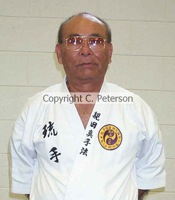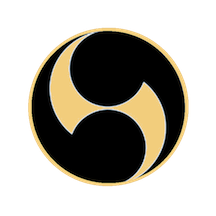
Taika Seiyu Oyata
Grandmaster Taika Seiyu Oyata, has devoted his whole life to studying and perfecting his karate technique. He was fortunate to have studied with Okinawa's greatest masters, and would not have been able to if not for his family heritage. Oyata's heritage dates back to the days of the Okinawan Emperor. His family, Zana Oyakata ( oyakata is a Title) were the Emperor's advisor. During the feudal era of the Ryu Kyu's society was divided into 3 classes. Royal Class, Warrior Class, and Common Class.The Royal Class consisted of 3 positions; Emperor, Oyakata, and Anshi. The Warrior class had many levels, depending on wealth and position, and the common class consisted of merchant, farmers, and fisherman.
When Okinawa was invaded by Japan in 1609, the Emperor was captured and the Zana family head resisted and was killed. According to the Zana family legend, the Japanese invaders ordered the family name changed to Shinda, symbolizing death, to prevent any further resistance. The family changed the pronunciation to Oyata, although the characters can still be pronounced as "Shinda".
Oyata's father. Kana Oyata, was the middle weight sumo champion of all Okinawa. Kana Oyata's first three sons were all killed in WWII. Seiyu, Kana's fourth son served in the Japanese Navy during WWII as a Lieutenant. If the war would have lasted a few more months,, Oyata would not be here today. He was scheduled for a suicide mission, and a death certificate had already been mailed to his family.
Oyata's first serious interest in martial arts began when he entered the Japanese Navy. There he was introduced to various Japanese martial arts as part of his training.These included, Judo, Kendo, Naginata, Yari, and Iaido. He studied sword drawing from an old Bushi warrior whose style was Gogai-Ryu.
After the war Oyata began working for the US Army, delivering food and supplies to some of the surrounding islands. Going to a different island each day. Around 1946 Oyata's work took him to the town of Teruma Where he met a very large old man who still wore a warriors top knot. This was very unusual during this time as wearing a top knot was outlawed in the late 1800's. This gentleman was Uhugushuku Tan Mei, a former bushi, who had been in service to the Okinawan Emperor. (Tan Mei is a title given to a warrior or upper class citizen). The Uhugushuku family has a long history of service to the Okinawan Emperor. The most famous Kenyu "Uni" Uhugushuku was instrumental in Emperor Sho Toku's defeat of a major enemy.
The Uhugushuku family is very famous for their karate and Kobudo ( weapons) techniques. The 6 ft. Bo and the 4 ft. Jo are the family specialties, but they all possessed great skill in all weapons and empty hand techniques.
Because of his hertage, Taika Oyata became Uhugushuku's personal student and trained with him daily until Uhugushuku's death. Training was very different, because he used his techniques as a warrior, not for show. But also in what he taught. History, fighting theory, how to study technique and the weapons kata.
Taika was also introduced to Uhugushuku's best friend; Wakinaguri Tan Mei. Wakinaguri was a Chinese gentleman about the same age as Uhugushuku, living in Okinawa. Wakinaguri was from a 6 generation warrior family. They specialized in nerve and blood vessel strikes (Kyu Sho Jitsu). Wakinaguri was stocky and very strong. One unique feature that set him apart from others was that all of his fingers were of the same length, due to pounding his fingers into coral pumice all his life. Taika studied with him learning and discovering the bodies weak points and vital areas, as well as how to strike. With this knowledge, he began to research the kata to discover their hidden meanings.
Because of Taika's natural ability, and extreme dedication, Uhugushuku and Wakinaguri presented Taika with a scroll, stating his abilities, and naming him successor of the family martial arts system. While not a rank certificate, it still gave Taika permission to teach their family Martial Arts systems. With this, he was also given the Uhugushuku family stone signature seal.
Continuing his search for knowledge, Oyata sought out other masters. And because of his heritage and ties with Uhugushuku, he was accepted a s a student/ instructor under Shigeru Nakamura. It was from Nakamura, that Taika learned the 12 kata of our style. Nakamura was also known for his strong punching technique and was responsible for the use of Bogu Gear in the Okinawan Karate Championships. Under Nakamuras direction, Taika developed very strong punching techniques. In the mid 1960's, Taika entered a large tournament in southern Japan, attracting all the top karate men from Japan and Okinawa. The Okinawans took 1st, 2nd, and 3rd place. Taika Oyata, at the age of 38 took 1st place and became champion of Okinawa as well as Japan.
In 1968 Taika came to the USA for the first time at the request of his most senior students, and established his first International Association, and started introducing his art through camps and seminars. After going home to Okinawa for a brief time, he returned in 1977 to the USA to become a permanent resident.Taika Oyata passed away in June 12th 2012 after a brief battle with cancer, at the age of 83.


